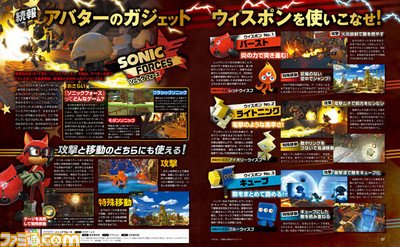SEGA has published a batch of new information on Sonic Forces that introduces more details to Wispon(the weapon gadget powered by Wisps), which is used by the player-created Avatar. Japanese magazine Famitsu also has a new interview with Sonic Forces producer Shun Nakamura and Sonic series producer Takashi Iizuka, which gives more insight to the game’s storyline and music. The interview has now been translated, click to read the full interview!

Famitsu: In Tokyo Game Show 2017, you have finally revealed the first playable version in Japan.
Nakamura: In the trial version, we have prepared various controls for Modern, Classic, Avatar, and Tag styles. We judged that if we were to omit even one of them it would end up looking the same as past Sonic series, so we’ve put in a lot of styles.
Famitsu: In addition to the many styles, we’re also surprised that the action changes drastically with the Wispon used by the Avatar.
Nakamura: After pursuing the question of “What is a high-speed action that’s different from Sonic?” we came to a conclusion that we want [players] to enjoy various kinds of actions, so we made this system.
Famitsu: How did the idea of Wispons come from?
Iizuka: We’ve decided from the early phase that we’d make them gadgets that use the power of Wisps. And after that, we thought to refer them from the power of the source Wisps. In the end, Wispons are just gadgets for the civilian Avatar who stands up against Eggman’s army.
Nakamura: Sonic is a hero, while the Avatar is a civilian. We focused on how commoners can follow up with the lack of power. It’s the same case for Wispons; for example, it can use wires to move with a speed almost as fast as Sonic.
Famitsu: You’ve introduced a number of them this time, but are there any other kinds of Wispons out there?
Iizuka: That’s still a secret. I hope all the fans will get to imagine based on the Wisps that have appeared in the past.
Nakamura: There are various kinds of Wispons, so we want you to enjoy playthrough methods such as “using this Wispon to go through this stage.”
Famitsu: In stages where the Avatar and Sonic work together, you control both characters by yourself, which feels so fresh.
Nakamura: Until now there had been a proposal of a gameplay to proceed while switching characters, but if we just switch them with a button, the tempo inevitably would become slower. We thought to remove those troublesome things, so we adopted the controls where if you use Boost (the player character) will switch to Sonic, and if you use the Wispon then it will switch to the Avatar.
Famitsu: How has the sound department been doing?
Nakamura: This time Mr. (Tomoya) Ohtani works as the sound director. He had previously worked on Sonic Lost World and Sonic Colors, but he also has a characteristic of changing the musical direction based on the character. Speaking tangibly, the Avatar has vocal songs, Classic Sonic has old-school game melodies, Modern Sonic has rock music, and the important scenes have an orchestra, so he is providing a broad range of genres.
Famitsu: Finally, please leave a message to the readers!
Nakamura: There are obviously a lot of features that will please Sonic fans, from the scenario, music, to action. The new Avatar feature is a feature that will become enjoyable even to people who never know of Sonic before. We want this Sonic Forces to be enjoyed by many people worldwide.
Iizuka: We injected all the passion that we had on Sonic Adventure, but our feelings this time [in Sonic Forces] are close to that. This game’s contents will be like a compilation so that people who have been waiting for a proper [new iteration in] modern Sonic series for a long time will be satisfied, so please look forward to it. Those who have played Sonic Mania, which was released in August, will grin when looking at some of the scenes here, so we’ll be glad if you play [Sonic Mania] before [Sonic Forces’] release.



